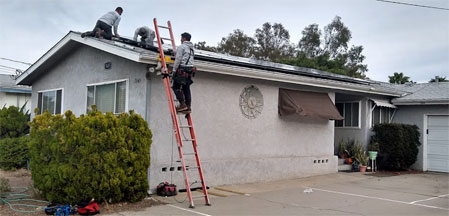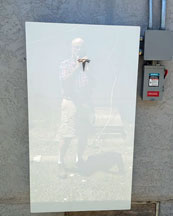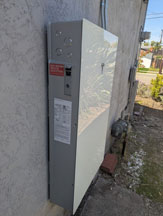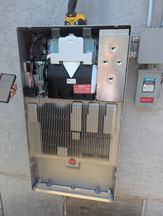
Copyright Mark D. Martin 2004-2025, All Rights Reserved
 Copyright Mark D. Martin 2004-2025, All Rights Reserved |
| Home | | | Photos | | | Museum | | | Energy & Environment | | | Links | | | Martin | | | |




Welcome to the 2024 Solar Energy page with information about my solar voltaic system installed in 2024. This system replaced my original system installed in 2006. That system was starting to fail in 2024 when I noticed shattering of a panel. I learned there was a class action lawsuit against BP Solar claiming that "the panels were defective and prone to junction box failures." My panels were covered. I chose to have the panels removed and received a cash settlement. After removal, I had a new 15 panel system installed with a Tesla Powerwall 3 battery. The new system does not have the favorable Net metering 2.0 that the old panels had. The Net metering 2.0 would have expired in another two years anyway, however, for the old system. The new system is much more efficient than the old system generating nearly three times the amount of electricity. This combined with the Tesla Powerwall 3 provides nearly free energy for my house and also for charging my 2018 Hyundai Ioniq Plug-In Hybrid car. Since I am retired I can charge my car at home during the day when my system is providing excess energy.
Roof Replacement. Prior to installing the new system I had the roof replaced. The old roof was at least 35 years old and perhaps considerably older. The new roof is an Owens Corning TruDefinition Duration COOL in Shasta White. This is a highly reflective roof which should contribute to cooler interior house temperatures in the summer. Once the roof was installed, it was time for the new solar.
Price of Solar Per Watt Dramatically Lower than in 2006. After receiving multiple bids, I choose Stellar Solar as the solar contractor. They installed 15 Canadian Solar CS3N-390MS 390 watt panels for a total system size of 5.85 kilowatts DC (5.38 kw AC) for a price of $11,700. They were running a sale at the time with 15 panels for the price of 10 panels. There was a 130% increase in panel efficiency from the 2006 system with the old 170 watt old panels compared to the new 390 watt panels. The total system size went from 2.04 kilowatts (12 panels x 170 watts) to 5.85 kilowatts (15 panels x 390 watts), a 187% increase. The old system price was $16,510 which included the inverter. The 2006 system price was $8.09 per watt vs. $2 per watt for the 2024 system. While this comparison does not include the inverter for the 2024 system, it also does not account for a 50% increase in inflation from 2006 to 2024. Bottom line - the price of solar has gone down dramatically.
Government Incentives and Net Metering. The government incentives have changed over time also. In 2006 there was a $4,710 state incentive and a $2,000 federal income tax credit. There was also full net metering (California's net metering 2.0 or 1.0) where excess power sent to the grid was credited to me at the full retail rate. Under California's net metering 3.0, which went into effect on April 15, 2023, customers are only compensated at the utility's avoided costs which according to Energy Sage is about 75% less. The rate structure is fairly complex and it looks even less favorable to me. The problem with solar energy, of course, is that it is intermittent. As solar energy becomes more common, there can be an excess in mid day when the sun is shinning. The value of solar during this time is reduced and can even be negative. The change in net metering encourages customers to combine their solar system with batteries. That way at least some of the excess solar produced during the day can be stored and used in the evening and night when the sun is not shining. This is why I got a Tesla Powerwall 3 battery with my system.
Powerwall 3, 2024 Incentives, and San Diego Community Power. The Powerwall 3 including installation was an additional $15,250. Under current law the solar system and battery costs qualify for a 30% tax credit. Unfortunately, this credit is likely go away in 2026 under the most recent proposals by the Trump administration and Republican Congress. In addition to the 30% tax credit, about $9,100 of my Powerwall was reimbursed to me by San Diego Community Power. (SDCP). SDCP is a Community Choice Aggregator (CCA), a non-profit public agency that purchases power and supplies it to customers. The utility, San Diego Gas and Electric, still delivers the power through their transmission lines. In return for their payment of a portion of the battery cost, SDCP can take 50% of my battery storage every day from 7:00 to 9:00 p.m. As a practical matter, that leaves only 20 to 30% of the battery for me to use for the remainder of the night and early morning. That's because the battery is set to be discharged only down to 20% to help maintain the battery and prolong its life. This has been fine, however, since it usually gets me to the super off-peak rates from midnight to 6 a.m. Additionally, San Diego Community Power pays me 10 cents per kilowatt hour they take. Since they take about 6 kilowatt hours a night, that equals about 60 cents a day or about $18 per month. This is in addition net metering compensation for excess power delivered to the grid during the day. The system was just installed in December 2024. As I write this in late June 2025, I haven't been through a full year. By the end of the year, I'm hopeful that I will end up basically not paying any net amount for my electricity use.
Solar Energy and Battery Storage Makes Financial Sense. In 2007 when I wrote the webpage about my first solar voltaic system I wrote: "Even with government incentives, the pay back time on solar voltaic systems is still long. The prices keep coming down and the price of electricity keeps going up, however." As indicated above, prices for solar indeed came down dramatically. Electricity prices in San Diego indeed went up dramatically. In 2006 SDG&E's baseline rate was about 7 cents per kilowatt hour. (Historical Tariff .Schedules.) In 2025 summer baseline rates are about 43 cents per kilowatt hour - over 7 times more! (SDGE 2025 Residential Rates.) That's more than a 500% increase. During that same time overall inflation only increased about 58%. With my system I think I will basically be getting my home electricity and charging my car for free after the original investment. The pay back time is short. On a financial basis alone the message in 2025 is clear. GET SOLAR and a BATTERY! This is especially true in the San Diego area with expensive electricity, a mild climate and excellent solar exposure. As I indicated in 2007, however, it is not just about saving money. It is eliminating the emission of carbon dioxide from the burning of fossil fuels which is the main cause of current climate change.
A Community Benefit. As indicated above, the beauty of combining the solar panels with the battery is that I don't need to use electricity from the grid during the peak times of 4:00 p.m. to 9:00 p.m. This is when people are coming home from work or school and using the most electricity. This is also when the sunshine is declining. Having the stored power from the battery not only benefits me, it benefits the community which is using my shared energy under my agreement with SDCP. As I write this in June 2025 at 7:50 p.m., my home discharging 2.7kW of power as part of 680 "Fleet Homes" which provide a total of 2.7MW of power. This is power that would probably otherwise be generated by a natural gas peaking plant at a greater cost to SDCP and that would be discharging carbon dioxide to the atmosphere. (See Peaking Power Plant - Wikipedia.) This stored battery power is also providing energy from the sun for homes that don't have solar power. It's a win-win for everyone. An excellent book on the subject is Freeing Energy, How Innovators are Using Local-Scale SOLAR and BATTERIES to Disrupt the Global Energy Industry from the Outside In (2021) by Bill Nussey.
The Powerwall 3 App and Information Provided. The new system provides a lot more information to me than the old system did. The old system simply showed the amount of energy being generated on a small LED screen on the inverter. The current system gives detailed information on a Smartphone app. Among other things, it shows continuously how much power is being delivered to the home, how much is being delivered to or discharging from the battery, and how much is being sent to the grid or coming from the grid. It also shows the total amount of energy generated each day. My Tesla Powerwall has not been without it problems. While the unit itself worked fine, for the first few months it was often sending power to the grid instead of giving priority to charging the battery. I was therefore often left with a far from fully charged battery going into the evening even though there was more than enough sun during the day to fully charge the battery. This seemed like an easy problem to fix, but the first several calls and emails to Tesla did not fix the problem. Only after considerable complaining on my part was it raised to a second level. This worked and after several days of Tesla monitoring the system and changing settings the problems were resolved. It has been working fine since then. The Tesla Powerwall 3 itself is on the side of my house in a rather sleek looking unit that combines the battery and the inverter.
Once the issues were resolved, I've been very happy with the system. I will try and report back at the end of the first year after I receive my "true up" statement that reconciles my electricity usage and solar production over the course of a year.